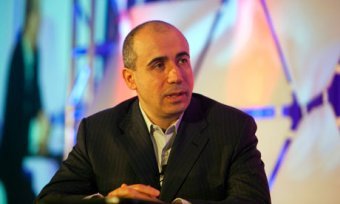Yuri Milner supports theoretical physics
 Russian billionaire who traded his scientific work for investing in social networks and other online projects, established the largest annual prize in the history of science - $ 3 M for each laureate (compared to last year's Nobel Prize of $ 1.1 M), reports Compulenta.ru portal referring on English The Guardian.
Russian billionaire who traded his scientific work for investing in social networks and other online projects, established the largest annual prize in the history of science - $ 3 M for each laureate (compared to last year's Nobel Prize of $ 1.1 M), reports Compulenta.ru portal referring on English The Guardian. Yuri Milner, who made his fortune by investing in Facebook, Twitter, Zynga and Groupon, found it necessary to encourage fundamental physics dealing with the basic laws of nature.
Mr. Milner, who has homes both in Silicon Valley and in Moscow, announced the list of first winners immediately and allocated $ 27 M. Nine lucky winners will form the awards committee which will select the winners of the next year.
The addition to the Nobel Prize has long suggested itself. Although the Swedish Committee did not pass over the fundamental science, the winners were usually the people in their declining years, because it takes decades to prove theoretical calculations. For example, Peter Higgs who predicted his boson 48 years ago. He is 83 years old now.
Mr. Milner stresses that his prize is not a competitor to Nobel, and points to a number of differences. First, it is designed for young theorists. Second, experimental verification is required. Thirdly, there is no limit to the number of winners, while the Nobel Prize can be shared no more than between three experts. Fourthly, anyone can put forward an applicant over the Internet, and award committee members openly discuss nominations - as opposed to Swedish colleagues.
Two more awards were instituted in addition to the main prize: New Horizons - an annual award for promising young physicists and a special bonus that can be given occasionally without any special ceremony.
Ph.D., a specialist in theoretical physics, Yuri Milner, who is fifty now, left Moscow State University in 1985. Then he received an MBA in Wharton School of Business at the University of Pennsylvania (USA).
The merits of the first nine winners are hard to explain to the public. For example, Maxim Kontsevich from the Institute for Advanced Scientific Research (France) was awarded for his contribution to the development of homological mirror symmetry and study of the phenomenon of links. And Alexei Kitaev from the California Institute of Technology (USA) won for his work on the use of topological phase of the wave function with anions and unpaired Majorana fermions.
Four awards went to the Institute for Advanced Study at Princeton University (USA) - Einstein’s former place of work. Juan Maldakena, Nathan Seyberg and Edward Witten awarded for their contribution to string theory, and Nima Arkani-Hamed - for an original approach to the unsolved problems of microphysics.
Ashoka Sen from Harish-Chandra Research Institute (India) awarded for his discovery that reveals the strong-weak duality in some supersymmetry string theories.
Alan Guth from MIT and Andrei Linde from Stanford University (both from the U.S.A.) received awards for their work on the inflationary model of the universe, which is widely recognized by cosmologists, but still have not seen by Nobel Committee.
Похожее
Yuri Milner increases the number of nominations in physics
Yury Milner will establish the largest award in the sphere of mathematics
Nobel Prize winner Alferov sees Russia ?on the sidelines of global technological development?
Yuri Milner is among largest investors of Rocket Internet incubator
Awarding the winners of Time for Innovations Award in Moscow
Winners of the contest “InnoStar” will be announced in December, 5